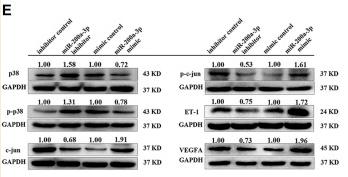EDN1 Antibody - #DF6125
| Product: | EDN1 Antibody |
| Catalog: | DF6125 |
| Description: | Rabbit polyclonal antibody to EDN1 |
| Application: | WB IHC |
| Cited expt.: | WB |
| Reactivity: | Human, Mouse, Rat |
| Mol.Wt.: | 24kDa; 24kD(Calculated). |
| Uniprot: | P05305 |
| RRID: | AB_2838092 |
Related Downloads
Protocols
Product Info
*The optimal dilutions should be determined by the end user. For optimal experimental results, antibody reuse is not recommended.
*Tips:
WB: For western blot detection of denatured protein samples. IHC: For immunohistochemical detection of paraffin sections (IHC-p) or frozen sections (IHC-f) of tissue samples. IF/ICC: For immunofluorescence detection of cell samples. ELISA(peptide): For ELISA detection of antigenic peptide.
Cite Format: Affinity Biosciences Cat# DF6125, RRID:AB_2838092.
Fold/Unfold
ARCND3; Big endothelin-1; EDN1; EDN1_HUMAN; ET-1; ET1; HDLCQ7; PPET1; Preproendothelin 1; Preproendothelin-1; QME;
Immunogens
A synthesized peptide derived from human EDN1, corresponding to a region within C-terminal amino acids.
Expressed in lung, placental stem villi vessels and in cultured placental vascular smooth muscle cells.
- P05305 EDN1_HUMAN:
- Protein BLAST With
- NCBI/
- ExPASy/
- Uniprot
MDYLLMIFSLLFVACQGAPETAVLGAELSAVGENGGEKPTPSPPWRLRRSKRCSCSSLMDKECVYFCHLDIIWVNTPEHVVPYGLGSPRSKRALENLLPTKATDRENRCQCASQKDKKCWNFCQAGKELRAEDIMEKDWNNHKKGKDCSKLGKKCIYQQLVRGRKIRRSSEEHLRQTRSETMRNSVKSSFHDPKLKGKPSRERYVTHNRAHW
Research Backgrounds
Endothelins are endothelium-derived vasoconstrictor peptides (By similarity). Probable ligand for G-protein coupled receptors EDNRA and EDNRB which activates PTK2B, BCAR1, BCAR3 and, GTPases RAP1 and RHOA cascade in glomerular mesangial cells.
Secreted.
Expressed in lung, placental stem villi vessels and in cultured placental vascular smooth muscle cells.
Belongs to the endothelin/sarafotoxin family.
Research Fields
· Environmental Information Processing > Signal transduction > HIF-1 signaling pathway. (View pathway)
· Environmental Information Processing > Signal transduction > TNF signaling pathway. (View pathway)
· Organismal Systems > Endocrine system > Melanogenesis.
· Organismal Systems > Endocrine system > Relaxin signaling pathway.
References
Application: IF/ICC Species: Rat Sample:
Application: WB Species: Human Sample: HUVEC
Restrictive clause
Affinity Biosciences tests all products strictly. Citations are provided as a resource for additional applications that have not been validated by Affinity Biosciences. Please choose the appropriate format for each application and consult Materials and Methods sections for additional details about the use of any product in these publications.
For Research Use Only.
Not for use in diagnostic or therapeutic procedures. Not for resale. Not for distribution without written consent. Affinity Biosciences will not be held responsible for patent infringement or other violations that may occur with the use of our products. Affinity Biosciences, Affinity Biosciences Logo and all other trademarks are the property of Affinity Biosciences LTD.

